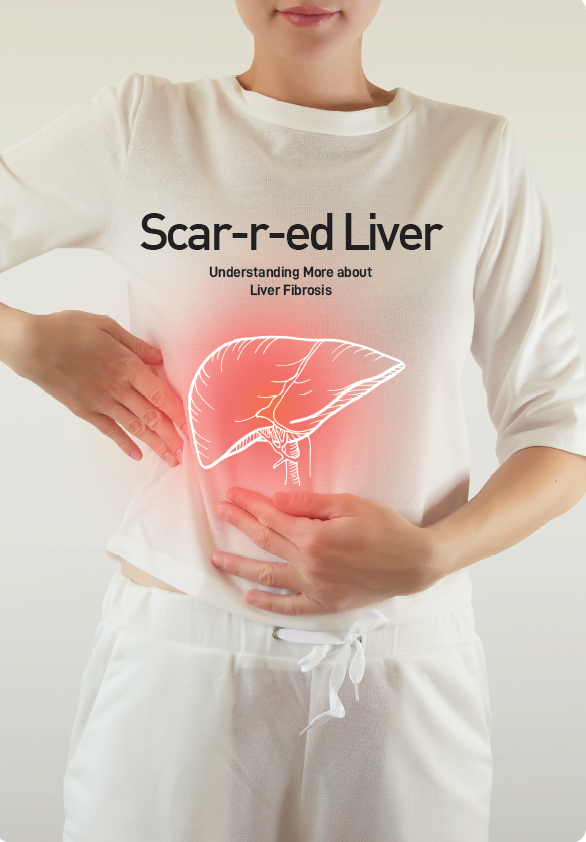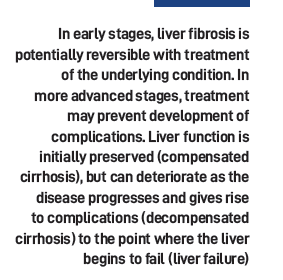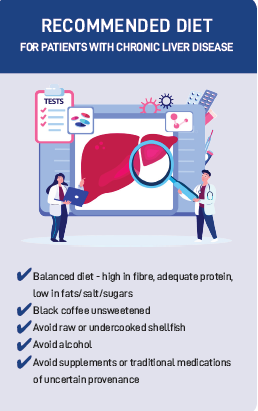
Mr Chan is a middle-aged gentleman with a history of chronic hepatitis B. He had been on follow-up with his neighbourhood polyclinic before they referred him for further evaluation for scarring of the liver through ultrasound scan.
When he first came to see me, Mr Chan was very worried as he had heard from his friends that scarring of the liver, also known as liver fibrosis, was an irreversible and life-limiting illness. I reassured him that although liver fibrosis should be taken seriously, progression of fibrosis and consequent development of complications can be prevented – if the disease is diagnosed and treated early.
LIVER FIBROSIS AND CIRRHOSIS
Liver fibrosis is the formation of scar tissue in response to injury of the liver. When there is damage or injury to the liver, damaged liver cells send signals to activate repair cells and stimulate them to secrete substances. One of the substances that is secreted is collagen, which is a type of fibre.


Over time, with ongoing injury or inflammation, collagen accumulates within the liver. This leads to the formation of scar tissue and stiffening of liver tissue. Scar tissue limits blood flow within the liver, restricting blood flow to healthy liver cells. The liver then becomes progressively irregular and nodular. Over the course of one to two decades, liver fibrosis can progress from mild to advanced fibrosis. Eventually, it may turn into liver cirrhosis, where there is permanent damage and severe scarring of the liver.
CAUSES AND SYMPTOMS
Common causes of liver fibrosis include chronic viral hepatitis B and C, non-alcoholic fatty liver disease (NAFLD), and alcoholic liver disease.
In liver fibrosis and early cirrhosis, patients may not experience any symptoms. In advanced cirrhosis, complications may develop and there may be symptoms, such as yellowing of skin and eyes, abdominal distension, vomiting of fresh blood or passing of black stool, easy bruising of the skin, confusion and disorientation, or disturbances in sleep pattern. There is also an increased risk of developing liver cancer.
ASSESSMENT
Non-invasive assessment of liver fibrosis can be estimated with composite scores based on numerous blood tests, and imaging in the form of transient elastography (Fibroscan) or magnetic resonance elastography (MRE), which is a type of MRI scan. Scarring causes an increase in stiffness of liver tissue, and a Fibroscan is able to estimate liver stiffness with an external probe that measures the speed of sound waves passing through liver tissue. Blood test composite scores, such as NAFLD fibrosis score (NFS) and Fibrosis-4 (FIB- 4) score, are validated scores that are reliable to exclude advanced fibrosis. Based on liver stiffness measurement, fibrosis is staged from F0 to F4, where F0 denotes no fibrosis; F1 represents portal fibrosis without septa (mild); F2 refers to portal fibrosis with rare septa (moderate); F3 means numerous septa without cirrhosis (severe); and F4 denotes the stage of cirrhosis.
However, liver biopsy remains the gold standard for diagnosis and staging of fibrosis. It is an invasive procedure to obtain cells from the liver for microscopic examination in determining the degree of inflammation and fibrosis. Assessment of liver fibrosis is essential in guiding decisions on treatment and predicting outcomes: the higher the stage of fibrosis, the higher the risk of developing cirrhosis and liver-related complications. Fibrosis has been shown to be the most significant predictor of progression to liver-related clinical outcomes.
Fortunately, in the case of Mr Chan, he did not have any symptoms and upon examination, he did not show any signs of chronic liver disease as well. Blood tests, such as liver function test and hepatitis B viral load, were conducted and Fibroscan was performed, which indicated that he had stage 3 fibrosis.
TREATMENT
- Treatment of underlying condition
The most effective method of treating liver fibrosis is to address the underlying condition. For example, Mr Chan was started on anti-viral medication for his hepatitis B. He was also encouraged to maintain a healthy lifestyle by implementing dietary changes and an exercise plan – 30 minutes of moderate intensity exercise at least 5 times a week.

In early stages, liver fibrosis is potentially reversible with treatment of the underlying condition. In more advanced stages, treatment may prevent development of complications. Liver function is initially preserved (compensated cirrhosis), but can deteriorate as the disease progresses and gives rise to complications (decompensated cirrhosis) to the point where the liver begins to fail (liver failure). Once complications occur, there is a shift in focus towards management of these complications and consideration of liver transplantation or palliative care, depending on the individual patient’s background and clinical condition.
- Surveillance and treatment of complications
Complications of liver cirrhosis include:
- Jaundice (yellowing of skin and eyes)
- Ascites (accumulation of fluid in the abdomen)
- Bleeding due to increased pressure within the portal circulation (circulation of blood between gut and liver) which results in formation of enlarged veins, also known as varices, in the oesophagus or the stomach
- Encephalopathy (difficulty concentrating, confusion, disorientation)
- Increased susceptibility to infections
- Increased risk of developing liver cancer
Patients with advanced fibrosis and cirrhosis should be reviewed at least once every six months for symptoms. They should undergo blood tests to evaluate their liver function. Surveillance for liver cancer with ultrasound of the liver is recommended once every six months to look for new growths.
In addition, patients with low platelet count or high liver stiffness measurement may be recommended to undergo oesophagogastroduodenoscopy (OGD) to screen for varices, They should also consider further treatment with medications or band ligation of varices, where appropriate.
THE CASE OF MR CHAN
In the case of Mr Chan, at the end of our consult, he shared that he is now more confident in managing his condition. As can be seen from Mr Chan’s case, with the right diagnosis and treatment, liver fibrosis patients can look forward to good management of their condition and a better quality of life.
Dr Loo Wai Mun
Senior Consultant GastroenterologistAliveoMedical
BM (UK), MRCP (UK), SAB (Gastroenterology
/AliveoMedical/
Dr Loo Wai Mun is a Gastroenterologist with a wealth of clinical experience in the treatment of gastroenterology and hepatology conditions. She has sub-specialty interests in non-alcoholic fatty liver disease (NAFLD) and liver-related disorders. Prior to joining AliveoMedical, Dr Loo served as a Consultant in the Division of Gastroenterology and Hepatology at National University Hospital (NUH) and Alexandra Hospital. Dr Loo treats all gastroenterology and hepatology conditions, and is experienced in endoscopic procedures such as gastroscopy, colonoscopy, polypectomy as well as endoscopic haemostasis. She has vast experience in the management of liver conditions. Dr Loo was also the clinical lead for the Fatty Liver subspecialty service at the National University Hospital and was instrumental in establishing the Fatty Liver Subspecialty Clinic there.
AliveoMedical
Mount Elizabeth Medical Centre
3 Mount Elizabeth #10-07 Singapore 228510
+65 6235-6136
Mount Elizabeth Novena Specialist Centre
38 Irrawaddy Road #09-44 Singapore 329563
+65 6268-8360
Mount Alvernia Medical Centre
820 Thomson Road, Block A #06-01 Singapore 574623
+65 6255-7336
www.aliveomedical.com













